The Volvo Factory Delivery Center
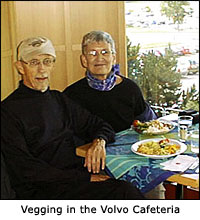
Here we are, two jet–lagged travelers vegging out at the Volvo cafeteria in Gothenburg, Sweden. For those of you who don't know, we've finally REALLY retired and are off to Europe for three months. We purchased a car directly from the Volvo factory. This great deal included two free round–trip tickets from Santa Cruz to Sweden and several other enticements!
We were treated royally by the company, including an overnight stay in a modern city center hotel, a great lunch, a tour of the factory, and more. In the cafeteria, we were impressed that each person cleared their own lunch tray – recycling everything, sorting their dirty dishes, scraping their plates – AND, there was a place to wash your hands at the end of the process.
This was just like summer camp only better! Modern production techniques are applied in the cafeteria as well as the assembly line! What a fine introduction to Sweden's environmental conservation policies at work. We're going to like Sweden where recycling is a genuine commitment.
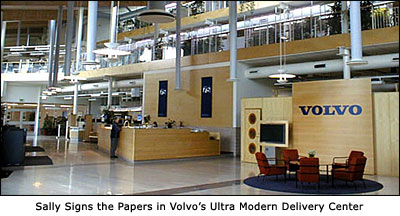
Sally signed her part of the paperwork at Volvo's ultra modern delivery center. This place is classy, and very professional. Contrary to the spiel given us by the salesman in Santa Cruz, there was no problem in registering the car in both our names. (Even though the salesman was more of a hinderance than help, we have since found that the dealer's service department is fantastic!) We bought a set of rubber mats to protect the carpet, and Volvo loaned us a car top carrier – no charge – for three months. And there it is! Our new car.
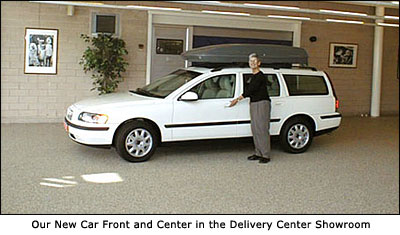
How do You Make a Volvo?
Welcome to the Volvo factory tour (Sorry – no photos allowed). It was a clean, quiet place even with the enormous presses stamping out auto body-parts. The cars are built by robots with the help of computers and a few people!
They start with a huge roll of steel that is "pressed" into doors, roofs, hoods, etc. Robots assemble and weld the hoods, fenders, side panels, roofs (with or without sun–roofs), etc! Then robots move the completed body along to join a matching power pack (a frame containing the motor, transmission, wheels, etc. that looks like a toy hot rod kit only much bigger) that was created on another assembly line.
People get to install the seats, add seat belts, wiring, light bulbs, etc. They carefully select what parts are put on each car since each one is built to order – your (or a dealer's) order sheet goes along on the assembly line with the car. With a factory order you get what you want for less. We got an extra 12V outlet for $25 rather than spending hundreds to get it as part of a special package back home.
What a fascinating process. Modern production techniques are a far cry from the abuses that occurred during the birth of the industrial revolution in England's mills. The workers who are members of teams seemed to be happy and smiling – some even waved at us along the way. Maybe that was because their 4 week holiday started the next day?
We learned about Volvo's enlightened worker approach and their environmental efforts: e.g. they stopped using mercury and other heavy metals in 2000. We couldn't help but draw the connection with one of our friend's scientific research on the effects of heavy metals on our environment, and the direct application of that research to Volvo's manufacturing processes. Thanks to science. And way to go, Volvo.
After the tour, Bill drove our new car out the bay doors of the showroom and onto the test track for a get acquainted spin. With five minutes of drive time logged, it was onto the rain slicked streets into Gothenburg's rush hour traffic. Brave Bill! Then we headed into the city's suburbs to visit a friend that we had met in the states.
Gothenburg – A City for Pedestrians
When we returned to Gothenburg city center, we delighted in the many pedestrian–only cobblestone streets with people riding bikes and moms pushing babies in grand prams. Everyone seemed to take coffee (and a sweet treat – Bill liked that part) around 4:00 p.m. to meet and visit with friends. What a clean, cosmopolitan, friendly city! People seemed relaxed, contemporary. We spent a few days purchasing supplies: a small 12V fridge for the car, camping stove, groceries, etc.
It seemed to take a long time as we sorted out the currency, located stores, AND figured out the street signs. Our friend had turned us on to a "bargain" store where we purchased pots, dishes, etc. all at a discount. We discovered a health food store one-half block from the hostel where we were staying and stocked up on organic rice, tofu, adzuki beans and sunflower seeds. Reluctantly, we left beautiful Gothenburg and headed toward Oslo.
On the Road
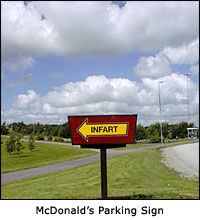
Follow us this–a–way! Sally got a huge laugh every time we saw one of these "gaseous" signs (meaning ‘Drive In'). This one was at the entrance to a McDonalds. Sally is still looking for the "outfart" sign. We did see many "pass farten" signs along the highway, which Sally took to mean "an area where it is OK to pass gas". (Actually they were asking us to ‘Drive Slowly'.)
Stopping for a sweet treat at the McDonalds, we saw many Swedish families eating with their children. We were impressed with the apparent family unity, father involvement, and their reasonably quiet, well-behaved children, especially since it was a fast food restaurant.
The Bohuslan Coast
Thank you Swedish friends for telling us to visit the incredible west coast of Sweden. On the way, we passed miles of small family farms with lush, rolling green fields and real cows grazing on real grass (not a feed lot in site). The many houses with red tile roofs were painted either barn red, white or yellow – wild flowers were everywhere. We headed toward the sea.
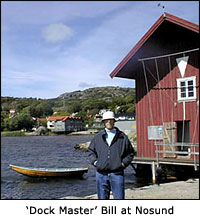
Here we found the quaint seaside village of Nosund with it's hidden coves and harbors. We strolled along a wooden footpath at the edge of the inlet to discover small dingys and sailing sloops. We spotted moon–jellies along the shore, millions of them, caught adrift in the beach wrack. We lay down on the path and hung our heads over the edge to get a closer look – communing with the jellies. Further down the path we saw two kids doing the same thing.
We climbed the hill to look at the view, watch a sailboat passing by, and say a prayer of gratitude for the opportunity to be here. Nosund was sprinkled with white cottages that have gingham checkered curtains and window boxes with geraniums. Eighteen hours of daylight brings profuse blooming – the Swedes love flowers.
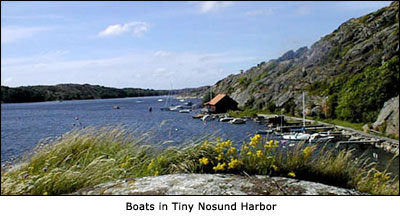
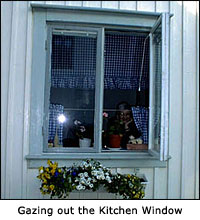
We stayed in a small hostel that was built by converting an old corn shed – with our own private deck and view of the sea. Guests were asked to recycle everything – there was no can for just trash – everything got recycled. Sally said "I have to take a picture of this window for my daughter in Alaska."
This town reminded Sally of a movie she once saw, something about an English holiday – was it "Julio's Holiday"? – where the characters wearing summer dresses and summer hats, strolled along to breathe in the fresh sea air.
Sally loved this kitchen! Crisp white, and blue, blue, blue. The gingham curtains are the same fabric as in her cottage in Quail Hollow! The ultra modern design is Sally's first choice for kitchen décor.
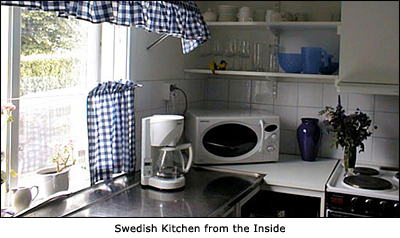
The Village of Fjallbacka
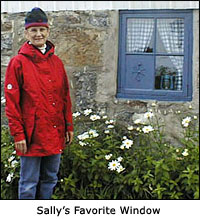
We discovered this village by accident – another quaint seaside town, where Swedish families come to vacation: sailing, canoeing, eating ice cream and sunbathing on the huge granite boulders found in this part of Sweden.
We rented a cottage (it's just behind our Volvo in the photo) close to a magnificent pink granite church. It was easy to hear the bells when they rang! Ingrid Bergman was born and raised here – she was probably baptized in that very church!
We took a day trip to the Bohuslan Museum and learned about the unique granite found only in this area. We also learned more about the Vikings – who started their sailing conquests right here.

And we saw a rare exhibit of shipwreck photos taken from the land, during the early 1900's by one man. As his life passion, he was one of the first on the scene to capture vivid images of these dramatic events – what photos!
The Vitlycke Museum
We drove out to visit the Bronze Age Rock Carvings at Vitlycke, a UNESCO World Heritage Site. The rock carvings (with their symbols of fertility, power, sexuality and love) are scattered across the farm fields. The Museum is located near one of the more elaborate examples of the carvings.
We were moved by the aesthetics and beauty of the Vitlycke Museum. The building design and simple exhibits conveyed a sense of the spiritual – and gave us a better understanding of the mystical meanings captured by the rock art.
On the way back, we stopped for a hike along the coast that was recommended by Anika and Gus, the owners of our cottage. Anika said "You must take this hike!" As we approached the trail head, we passed a small harbor and watched a family sailing lesson in progress. The girl in the photo couldn't have been more than eight years old.
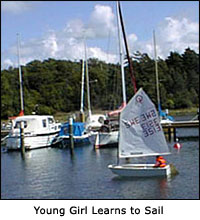
Family Values
She was expertly sailing the dingy around the harbor, while mom lent support from a nearby rowboat as did dad from the dock. Her brother, about age seven, was sailing in his own boat nearby. We were reminded once again of the emphasis on family unity that we observed in Sweden.
Our experience brought to mind Unitarian minister Robert Fulghum's kindergarten wisdom "when you go out into the world, hold hands" from his book All The Things I Really Needed To Know I Learned In Kindergarten. (We are members of the Unitarian fellowship in our home community.)
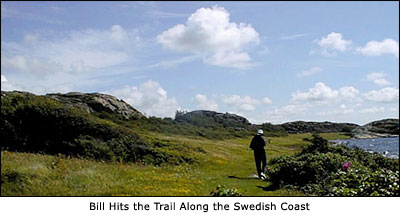
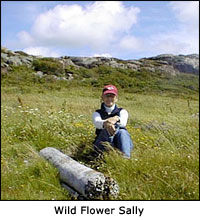
We headed up the trail to observe wild flowers, families picnicking, naked toddlers playing on the beach. The trail went through sheep fields, over boulders, sandy beaches, and along a wooden foot bridge that hugged the steep cliffs of pink granite. Bill's fear of heights gave him pause to walk carefully along the bridge.
We stopped to take in the view and smell the wild flowers. The next day we headed up to Oslo, Norway. We kept our Swedish Kroners since we knew that we would be back. Sweden is for keeping in our hearts.
| Veggie Gram Menu | Next Veggie Gram |